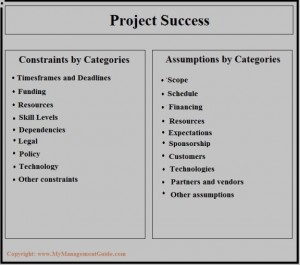Efficient planning for project success significantly depends on the right statement of the constraints and assumptions. Why are constraints and assumptions in project management so important? The answer is that because setting proper project constraints and assumptions paves the way for adequate risk analysis, efficient project planning and timely project delivery.
This article is intended to give you definitions of both project constraints and project assumptions and also show what steps can be taken to determine the key characteristics of project success.
Project Assumptions Definition
Before starting a new project, executives and other senior stakeholders must agree upon assumptions and produce a shared understanding of project success. This will reduce project failure rate and provide a foundation for developing risk mitigation strategies and contingency plans.
Project Assumptions are those events and circumstances that are expected to occur during the project life-cycle for successful implementation and completion. Although assumptions are the driving force that determines to project success, typically they’re outside the total control of the project team. Project assumptions are accepted as true, often without any proof or demonstration.
Project Constraints Definition
Any project is managed under a set of clear-cut constraints, and they need to be defined from the very beginning of the project. If the senior stakeholders clearly understand limitations of the project environment (such as due dates, funding, skill levels, resource availability etc.) under which the activities are to be performed, they will do a better job for ensuring project success and developing a well-grounded implementation plan.
In this context, Project Constraints are any events or circumstances that may restrict, limit, or regulate a project. Just like assumptions, typical project constraints are outside the total control of the project team.
Checklist
Here’s a typical 4-step checklist for setting project management assumptions and constraints:
- Assumptions. You’ll need to make a brief and clear-cut description of any project assumptions related to business, people, technology, expectations, or schedules. Then make a list of those assumptions and share it with the senior team for approval.
- Constraints. You will need to make a description of the major limitations impacting the project. Your description must include timelines, resource availability, funding, and other important factors that affect project success.
- Dependencies. It’s important to determine a link between project assumptions and constraints and then set any major dependencies between the characteristics. Once it’s done you’ll need to make a full description of the dependencies and use it in developing the project plan.
- Adjustment. If project assumptions and constraints are invalidated or they are likely to be modified at a later date, then you’ll need to make adjustments to the activities and estimates listed in your project plan accordingly.
Sample assumptions and constraints tend to exist around project resource availability or competence. That’s why, when developing a description of assumptions and constraints, try to give extra consideration to project cost, timing, and human-related issues.
It’ll be one of the first steps during the initiation phase. Once identified and agreed, sample assumptions and constraints in project management will be the foundation for managing unknowns and uncertainties – this is all about risk management.
Conclusion
It’s hard to overestimate the importance of setting right assumptions and constraints in project management. Although the planning process includes a lot of activities and tasks, project constraints and assumptions play a pivotal role in determining project success.
When you start a new project, you need to discus sample project assumptions and constraints with executives, stakeholders and team and then generate a common understanding of success. The given in this article project constraints and assumptions template shows you what key steps can be taken to make the planning process more efficient and increase the project success rate.

